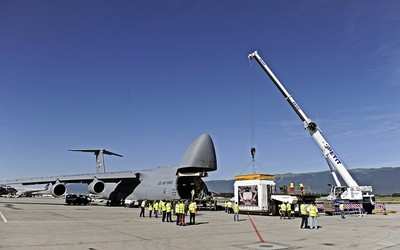Without The C-5M, Some Disassembly Would Have Been
Required
It's the physics community's billion-dollar baby -- a 7.5-ton
device so powerful that it could rock the core of modern science
and reveal a new chapter in the universe's history. And the
aptly-named C-5M Super Galaxy flew the device on its last
terrestrial journey August 26th before it travels on the final
space shuttle mission to the International Space Station.

Particle Detector Loaded Onto C-5M
A team of internationally renowned physicists led by Nobel
Laureate Dr. Sam Ting specially requested the U.S. Air Force's
largest, newly remodeled airlifter to transport the Alpha Magnetic
Spectrometer from the European Organization for Nuclear Research in
Switzerland to Kennedy Space Center, FL. "I'm very grateful the
U.S. Air Force came to help us," Dr. Ting said. The particle
detector is so large that, without the C-5, it would have required
a certain level of disassembly for its flight, he said.
The secrets that the AMS can decode are potentially so important
that hundreds of physicists from 16 countries came together to
build it. Although the project is officially sponsored by NASA and
the U.S. Department of Energy, nations around the globe have
collectively invested an estimated $2 billion to ensure its
success. The AMS team waited 16 years for the day they could
accompany it on to Kennedy Space Center. "We're so honored to be on
this flight," said Dr. Susan Ting, Professor Ting's wife and budget
manager for the project. "To have the U.S. Air Force take us home
is just ..." and she paused and smiled, then patted her hand over
her heart.

Soon after the Dover Air Force Base C-5M aircrew arrived in
Geneva to pick up the AMS August 25th, they were flooded by dozens
of suit-wearing European scientists armed with personal cameras and
questions. "'M' is for movie?" joked one Italian physicist about
the C-5's designator. Prior to arriving in Geneva, the aircrew had
dropped supplies off in Afghanistan and Iraq. The 14-person team
included active duty and Reserve Airmen working alongside one
another. They said they all felt honored to support the historic
event.
The mission was especially memorable for Capt. Matt Matis, who
completed his check ride as aircraft commander during the trip. As
he took a break from escorting scientists inside the plane, Captain
Matis said, "This is a great opportunity to showcase the aircraft
and do something different. A lot of these people have never seen a
C-5 before. They have a lot of questions about how it actually gets
off the ground. "They're as excited as we are, if not more," added
Captain Matis.
One man, after being introduced to Captain Matis, said jokingly
about the phrase painted on the side of the aircraft, "Instead of
'Spirit of Global Reach,' it should say 'Spirit of Global
Research.'"
"I find it fitting that AMC's oversize cargo aircraft is
delivering this device to another legendary transport, the space
shuttle," said Dr. Don Erbschloe, Air Mobility Command's chief
scientist. "NASA is watching this mission with great interest to
see how they might use the C-5M more in the future."
Dr. Ting and his international team faced many trials through
the years, to include last-minute modifications and shuttle
cancellation. But he said he was determined to see the only
physical science experiment on the International Space Station come
to fruition. During its 18 years of scheduled operation, the AMS is
expected to use its magnetic detection powers to survey charged
particles. While the European lab's Large Hadron Collider is famous
for its ability to charge particles at extremely high energies;
their levels are nothing compared to the energies of charged
particles found in space and the stories they can tell. "The cosmos
is the ultimate laboratory," Dr. Ting said.

But it's important to shed preconceived ideas, he said. For
example, the Hubble Telescope's purpose was galactic survey by
detecting light; and it stumbled upon the curvature of the
universe and existence of dark energy. Likewise, the hope is that
the AMS will stumble upon unchartered realms. "You always discover
something new, and that's what it's all about," Dr. Ting said.
After nearly two decades of laboring to get the AMS into space
to do its job, physicists at CERN were careful to run it through
every imaginable test to ensure it will survive the space
shuttle mission. It only follows that the lead scientists would
trust that the AMS would arrive unscathed after 11 hours aboard a
C-5. Regardless, the modernized Super Galaxies "ride like
Cadillacs," according to aircrew reports.
AMC began an aggressive program to modernize all remaining C-5Bs
and C-5Cs and many of the C-5As in its inventory. The C-5 Avionics
Modernization Program (AMP) began in 1998 and included upgraded
avionics, improved communications, new flat panel displays,
improved navigation and safety equipment, and a new autopilot
system. The first flight of the first AMP-modified C-5 (tail number
85-0004) occurred on Dec. 21, 2002.

File Photo
Another part of the C-5 modernization plan is the Reliability
Enhancement and Re-engining Program, or RERP, which includes new
General Electric CF6-80C2 engines, pylons and auxiliary power
units, with upgrades to the aircraft skin and frame, landing gear,
cockpit and pressurization system.
The C-5 aircraft that undergo both the AMP and RERP upgrades are
designated C-5M, also known as the "Super Galaxy." The Air Force
plans to upgrade 52 Galaxies to "super" status by the end of
2016.
 Classic Aero-TV: The Switchblade Flying Car FLIES!
Classic Aero-TV: The Switchblade Flying Car FLIES! ANN FAQ: Q&A 101
ANN FAQ: Q&A 101 ANN's Daily Aero-Term (04.12.24): Discrete Code
ANN's Daily Aero-Term (04.12.24): Discrete Code ANN's Daily Aero-Term (04.13.24): Beyond Visual Line Of Sight (BVLOS)
ANN's Daily Aero-Term (04.13.24): Beyond Visual Line Of Sight (BVLOS) ANN's Daily Aero-Linx (04.13.24)
ANN's Daily Aero-Linx (04.13.24)






